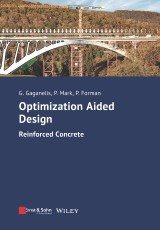Details

Optimization Aided Design
Reinforced Concrete1. Aufl.
|
61,99 € |
|
| Verlag: | Ernst & Sohn |
| Format: | |
| Veröffentl.: | 05.01.2022 |
| ISBN/EAN: | 9783433610718 |
| Sprache: | englisch |
| Anzahl Seiten: | 224 |
DRM-geschütztes eBook, Sie benötigen z.B. Adobe Digital Editions und eine Adobe ID zum Lesen.
Beschreibungen
Concrete is the most used building material. Its main component, cement, however, accounts production- related for up to 10 % of global CO2 emissions and is therefore a major contributor to human-induced climate change. Due to its low tensile strength, concrete must be further enhanced in tension with adequate reinforcement, such as steel. Producing the latter therefore additionally impacts the environment. Consequently, reducing the material amount for design and construction of structures, thus lowering material- and transport-induced emissions, represents a key element to climate protection. In this context, meeting the essential requirements ? sustainability, serviceability, durability ? is yet indispensable.<br> The book presents innovative optimization aided design methods for concrete structures. Mathematical optimization is applied to practical problems of structural concrete at each level: from external, through internal structure identification to cross-section design. It is shown how to design resource-efficient structures following the flux of forces, how to optimally adapt reinforcement layouts to the internal force flow, and how to efficiently cope with demanding cross-sectional design tasks such as biaxial bending.<br> The optimization aided design methods are discussed in detail and described vividly. They are independent of standards, concrete material (normal to ultra-high performance) and reinforcement type (steel fibers to carbon bars), thus universally applicable. The book illustrates the different approaches with numerous figures and calculation examples. Existing applications in structural engineering are presented to demonstrate the potential of optimization aided design concepts, including ultra-lightweight hybrid beams, thin concrete solar collectors, and improved reinforcement layouts for tunnel lining segments.<br>
Foreword<br> Preface<br> Acknowledgments<br> Acronyms<br> List of Examples<br> 1 INTRODUCTION<br> 2 FUNDAMENTALS OF REINFORCED CONCRETE DESIGN<br> 2.1 Basic Principles<br> 2.2. Verification Concept<br> 2.3 Safety Concept<br> 2.4 Materials<br> 2.5 Load-bearing Behavior<br> 3 FUNDAMENTALS OF STRUCTURAL OPTIMIZATION<br> 3.1 Structural Optimization Approaches<br> 3.2 Problem Statement<br> 3.3 Lagrange Function<br> 3.4 Sensitivity Analysis<br> 3.5 Solution Methods<br> 4 IDENTIFICATION OF STRUCTURES<br> 4.1 One-material Structures<br> 4.2 One-material Stress-biased Structures<br> 4.3 Bi-material Structures<br> 4.4 Examples<br> 4.5 Applications<br> 5 INTERNAL FORCE FLOW<br> 5.1 Preliminaries<br> 5.2 Continuum Topology Optimization (CTO) Approach<br> 5.3 Truss Topology Optimization (TTO) Approach<br> 5.4 Continuum-Truss Topology Optimization (CTTO) Approach<br> 5.5 Examples<br> 5.6 Applications<br> 6 DESIGN OF CROSS-SECTIONS<br> 6.1 Problem Statement<br> 6.2 Equilibrium Iteration<br> 6.3 Sectional Optimization<br> 6.4 Solving<br> 6.5 Parameterization<br> 6.6 Examples<br> BIBLIOGRAPHY<br>
There is hardly a topic among building professionals that is discussed more intensively than sustainable construction. (?) In view of the continuing increase in the world's population, we will not build less, but more. Contrary to this, we need to radically limit resource consumption and CO2 emissions. It is obvious that in the future, building will have to be completely different, not just marginally, but fundamentally. (?)<br> The methods, procedures and calculations described in this book represent an important step towards a kind of building that has little to do with the way we know it today. And this is a good thing.<br> (Prof. Dr.-Ing. Dr.-Ing. E. h. Manfred Curbach in his foreword.)<br> <br> The introduction of state-of-the-art optimization methods [to concrete design] and the resulting minimum-material component shapes, which also have a minimized need for reinforcing steel (?), promote construction with concrete that is characterized by considerable material savings and thus considerable emission savings for the same utility value and durability. Supported by clearly understandable descriptions and a large number of examples, readers will find their way around quickly and easily. This makes it much easier to understand the subject matter, which is not always simple.<br> This book provides a significant contribution to establishing a new foundation for building with concrete, this wonderful building material for everyone and for almost everything.<br> (Prof. em. Dr. Dr. E. h. Dr. h. c. Werner Sobek in his foreword.)<br>
Georgios Gaganelis is a structural designer for civil engineering structures and a freelance consultant in structural optimization. 2020 he received his PhD at the Ruhr University Bochum, Germany in the field of optimization strategies for concrete and steel-concrete-composite structures. His research interest focus on topology optimization and material driven steering. A special focus lies on ultra-light structures requiring minimal material efforts.<br> Peter Mark is a full professor for Structural Concrete at the Ruhr University Bochum, Germany. He is researching on applied optimization methods and lightweight concrete structures since 20 years. He received his PhD in 1994 and the post-doctoral degree in 2006. He is Consultant Engineer and Independent Checking Engineer since 2008 and involved in several bridge, tunnel and building construction projects.<br> Patrick Forman is a post-doctoral research fellow at the Institute of Concrete Structures at Ruhr University Bochum, Germany. He received his PhD in 2016. More than 10 years he is researching on lightweight shell and beam structures made of high-performance materials using various structural optimization techniques. Currently, he is technical and managing director of an interdisciplinary research centre on adaptive modularized construction methods.<br>
Diese Produkte könnten Sie auch interessieren:

Water Quality Hazards and Dispersion of Pollutants

von: Wlodzimierz Czernuszenko, Pawel Rowinski

149,79 €















